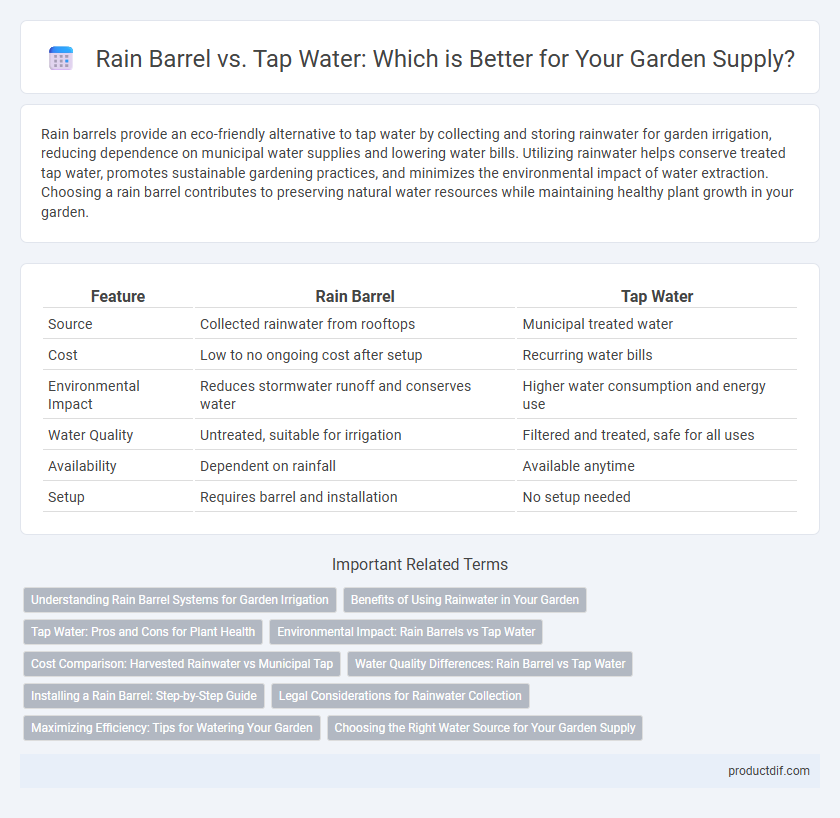Rain barrels provide an eco-friendly alternative to tap water by collecting and storing rainwater for garden irrigation, reducing dependence on municipal water supplies and lowering water bills. Utilizing rainwater helps conserve treated tap water, promotes sustainable gardening practices, and minimizes the environmental impact of water extraction. Choosing a rain barrel contributes to preserving natural water resources while maintaining healthy plant growth in your garden.
Table of Comparison
| Feature | Rain Barrel | Tap Water |
|---|---|---|
| Source | Collected rainwater from rooftops | Municipal treated water |
| Cost | Low to no ongoing cost after setup | Recurring water bills |
| Environmental Impact | Reduces stormwater runoff and conserves water | Higher water consumption and energy use |
| Water Quality | Untreated, suitable for irrigation | Filtered and treated, safe for all uses |
| Availability | Dependent on rainfall | Available anytime |
| Setup | Requires barrel and installation | No setup needed |
Understanding Rain Barrel Systems for Garden Irrigation
Rain barrel systems capture and store rainwater from rooftops, providing an eco-friendly, cost-effective alternative to tap water for garden irrigation. These systems reduce dependence on municipal water supplies, lower water bills, and help conserve natural resources by utilizing precipitation that would otherwise run off. Properly installed rain barrels can supply plants with nutrient-rich, chlorine-free water, promoting healthier garden growth compared to treated tap water.
Benefits of Using Rainwater in Your Garden
Using rainwater in your garden reduces dependence on municipal tap water, conserving a valuable resource and lowering water bills. Rainwater is naturally soft and free of chemicals like chlorine and fluoride, promoting healthier plants and vibrant soil. Collecting rainwater also helps manage stormwater runoff, preventing garden erosion and reducing the risk of flooding.
Tap Water: Pros and Cons for Plant Health
Tap water provides a consistent and readily available water source for plants, often containing essential minerals like calcium and magnesium that support plant growth. However, tap water quality varies by region and may contain chlorine or fluoride, which can harm sensitive plants or disrupt beneficial soil microorganisms. Regular testing and allowing tap water to sit before use can help mitigate negative effects on plant health.
Environmental Impact: Rain Barrels vs Tap Water
Rain barrels significantly reduce environmental impact by capturing and storing rainwater runoff, decreasing reliance on municipal tap water and conserving potable resources. Using rain barrel water minimizes energy consumption and greenhouse gas emissions associated with water treatment and distribution compared to tap water use. This sustainable practice helps mitigate stormwater runoff, reducing soil erosion and pollution in local waterways, promoting overall ecosystem health.
Cost Comparison: Harvested Rainwater vs Municipal Tap
Harvested rainwater significantly reduces garden watering costs by eliminating reliance on municipal tap water, which typically incurs charges based on consumption rates averaging $0.005 to $0.015 per gallon. Initial investment in rain barrels can range from $50 to $200, offering long-term savings as rainwater is free after installation compared to ongoing tap water expenses. Using rain barrels for irrigation not only conserves municipal water but also minimizes monthly utility bills, providing an eco-friendly and cost-effective garden supply solution.
Water Quality Differences: Rain Barrel vs Tap Water
Rain barrel water is naturally soft and free of chlorine, fluoride, and other chemicals found in tap water, making it ideal for garden plants sensitive to additives. Tap water is treated with disinfectants like chlorine to ensure safety for human consumption but may contain minerals and salts that can accumulate in soil and affect plant health. Gardeners often prefer rain barrel water for irrigation due to its neutral pH and lack of contaminants, promoting healthier plant growth and reducing reliance on municipal water supplies.
Installing a Rain Barrel: Step-by-Step Guide
Installing a rain barrel begins with selecting a suitable location near a downspout to capture maximum rainwater runoff. Elevate the barrel on a sturdy platform to ensure proper water flow and ease of access, then securely attach the diverter to direct rainwater into the barrel while filtering debris. Connect a spigot near the bottom of the barrel for easy water retrieval, and regularly maintain the system by cleaning filters and checking for leaks to optimize water conservation over tap usage.
Legal Considerations for Rainwater Collection
Rainwater collection regulations vary significantly by region, with some areas permitting rain barrels for non-potable use and others imposing strict limitations or requiring permits. Legal considerations often include restrictions on the volume of water collected, types of allowable containers, and intended use, such as irrigation versus potable use. Understanding local laws and water rights is essential to ensure compliance and avoid legal penalties when implementing rain barrel systems.
Maximizing Efficiency: Tips for Watering Your Garden
Rain barrels collect and store rainfall, reducing reliance on tap water and lowering water bills while conserving resources. Using rainwater for garden irrigation maximizes efficiency by providing plants with natural, chlorine-free water that supports healthier growth. To optimize water use, water gardens early in the morning or late in the evening to minimize evaporation and consider drip irrigation systems for targeted watering.
Choosing the Right Water Source for Your Garden Supply
Rain barrels collect and store natural rainfall, providing an eco-friendly and cost-effective water source that reduces reliance on municipal tap water. Using rain barrel water helps conserve tap water, lowers utility bills, and supports sustainable gardening by minimizing chemical additives commonly found in treated water. Selecting the right water source depends on garden size, local rainfall patterns, and plant water sensitivity, with rain barrels ideal for drought-tolerant plants and tap water suited for more delicate species requiring consistent hydration.
Rain barrel vs Tap water usage Infographic

 productdif.com
productdif.com